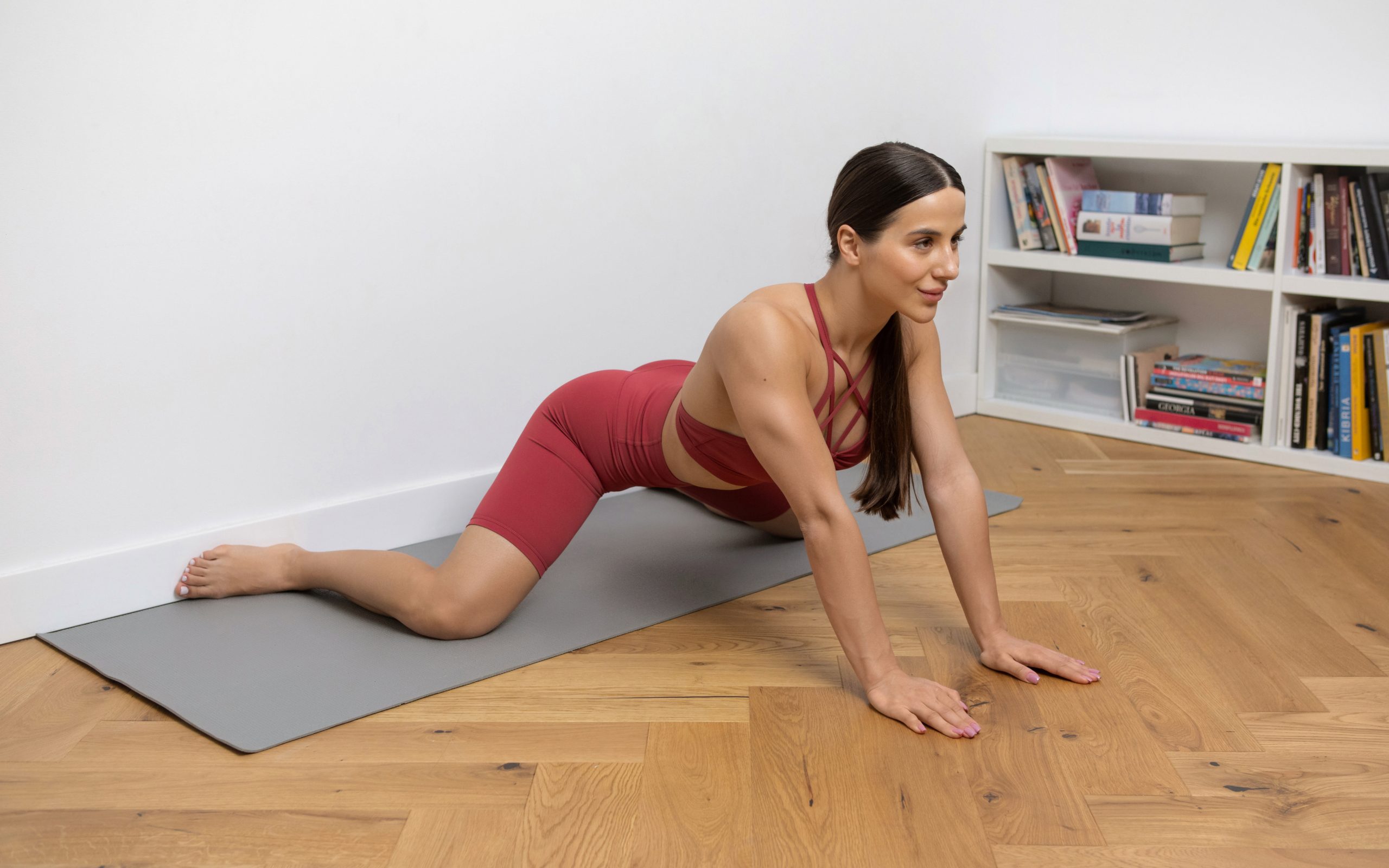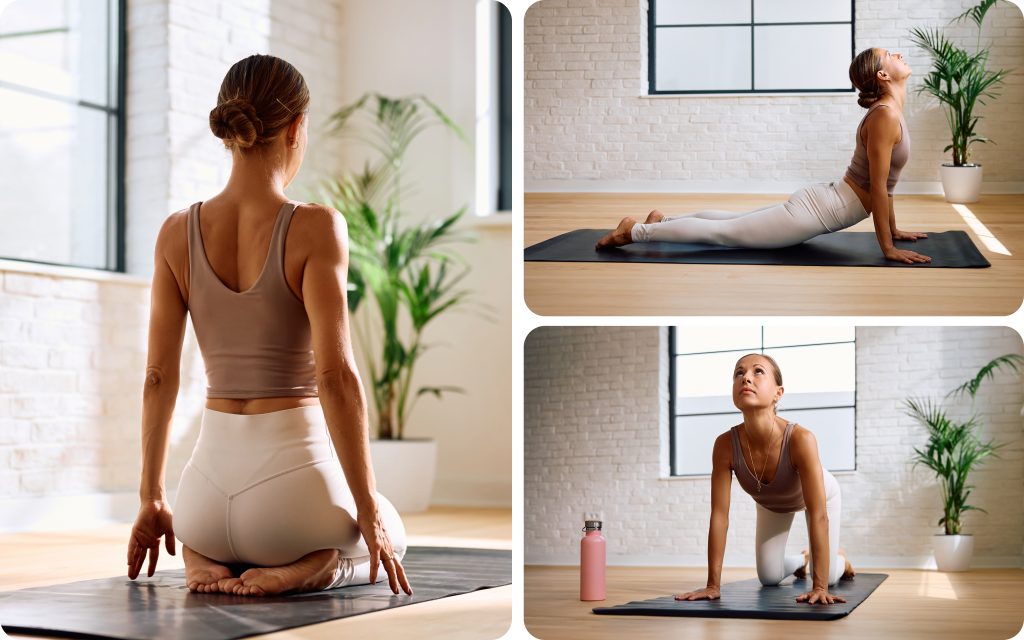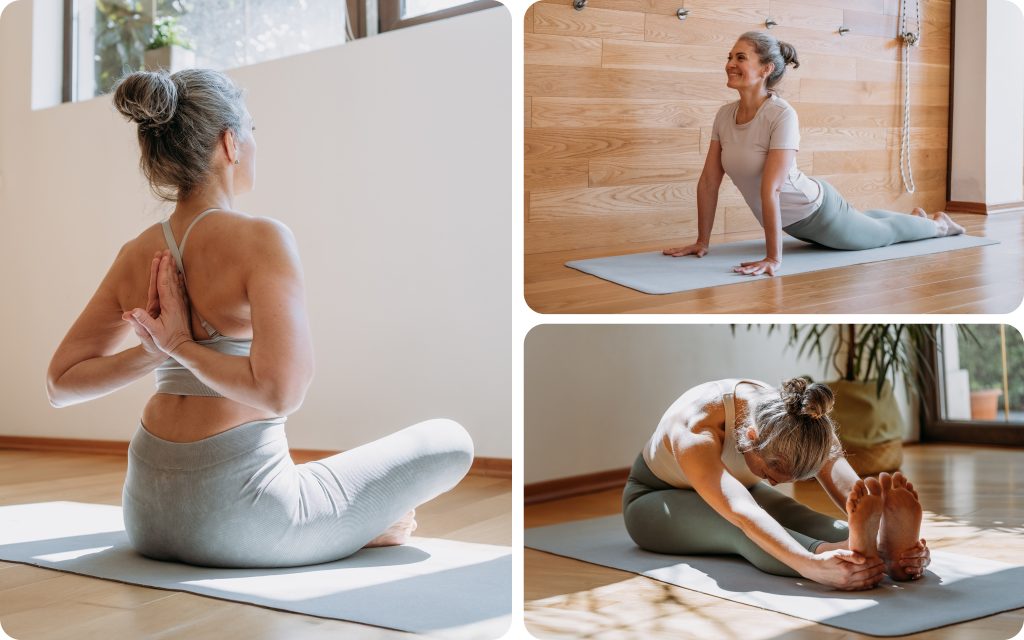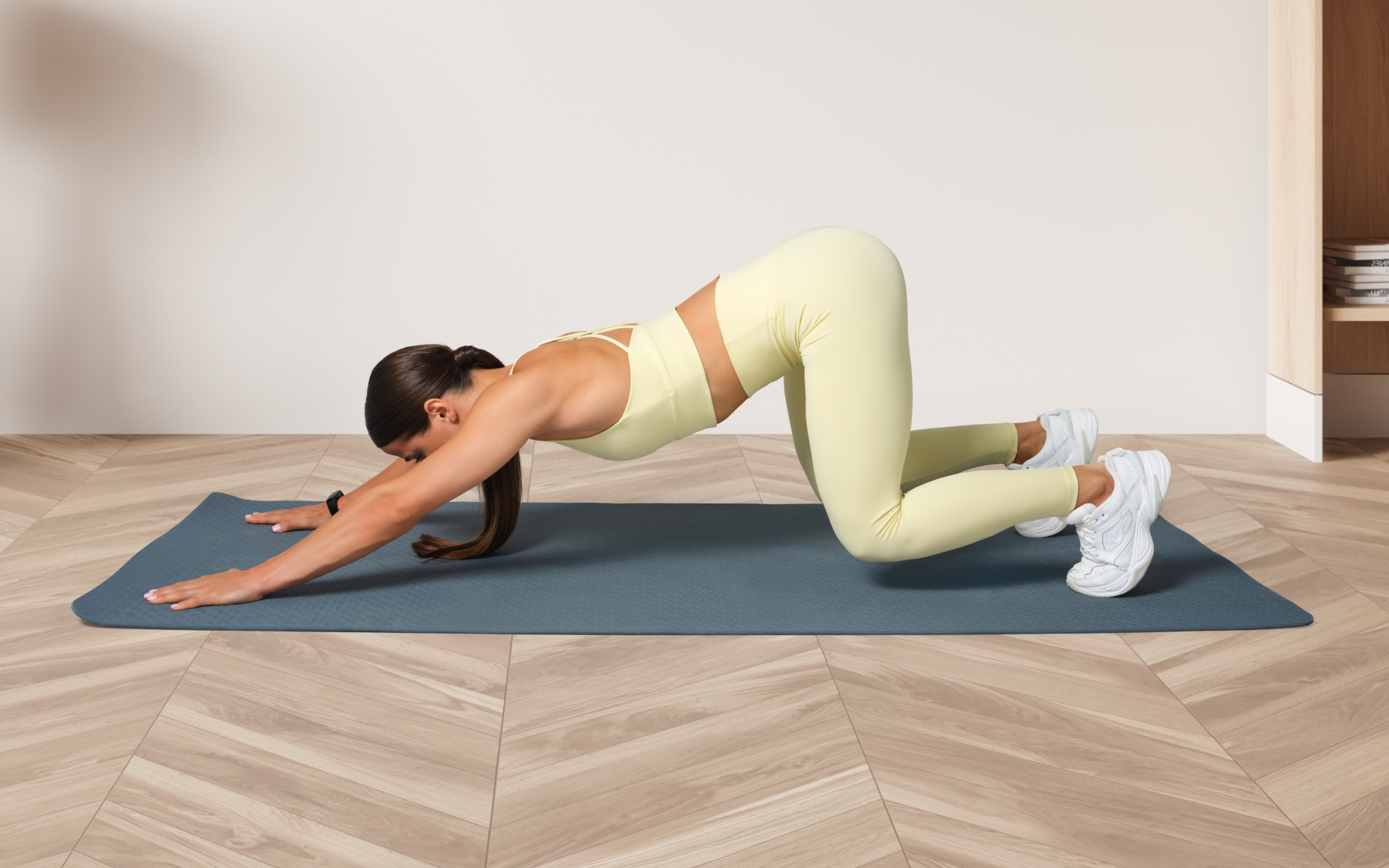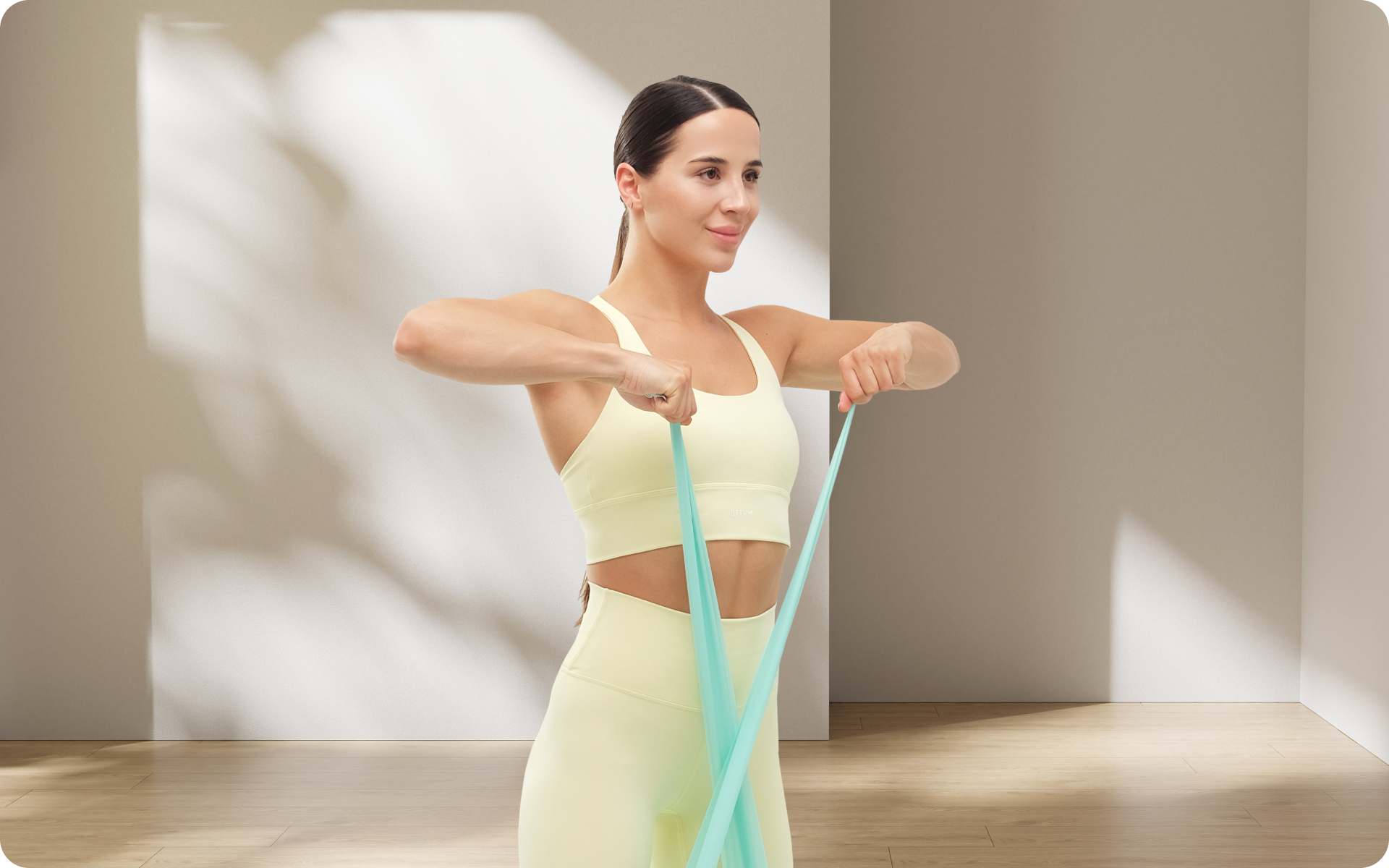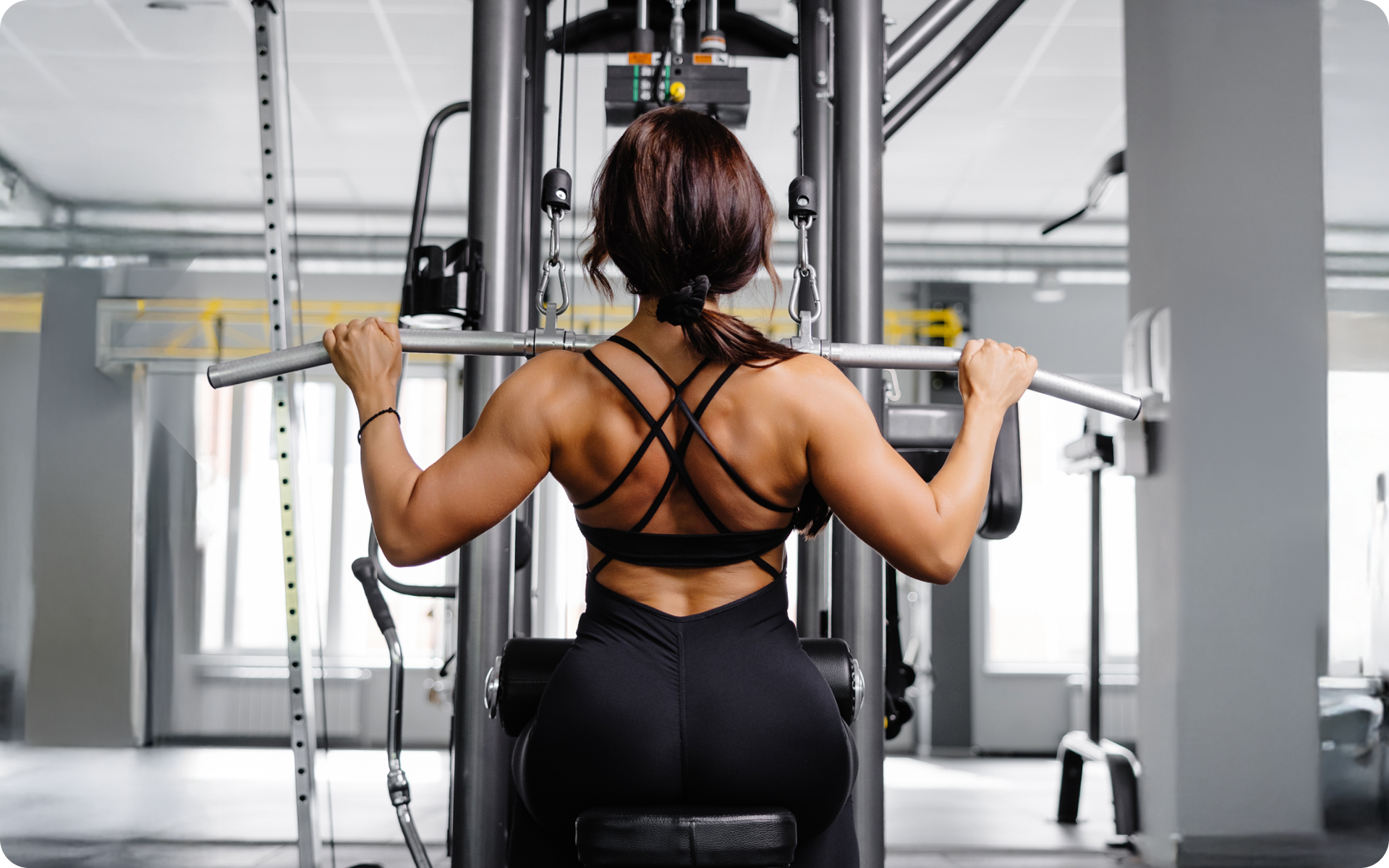Back pain is a common issue that can be debilitating. According to the American Chiropractic Association, nearly 31 million Americans experience lower-back pain at any given time.
There are many different causes of back pain, but one of the most common is tight or hypertonic muscles. When the muscles in your back are tight or overly active while at rest, this can lead to pain and discomfort. Modern life doesn’t help either. Many of us sit for long periods of time, often without postural variation, which can lead to tightness in the back and neck muscles (3).
Luckily, there are some easy static and dynamic stretches that can be effective for back tightness and hypertonicity. These stretches are perfect for beginners and can be done anywhere at any time.
If you’re dealing with back pain, be sure to talk to your doctor beforehand to ensure that any exercises you want to do are safe and tailored to your particular condition and requirements.
What Are Static and Dynamic Back Stretches?
Dynamic stretching involves moving parts of your body through a full or partial range of motion to warm up the muscles and increase blood flow. These stretches are typically performed before physical activity to prepare the body for movement and reduce the risk of injury. Examples include leg swings, arm circles, and walking lunges.
In contrast, static stretching involves holding a stretch for an extended period, usually 15-60 seconds, to lengthen muscles and improve flexibility. Static stretches are often performed after physical activity to help muscles recover and reduce soreness. Examples include touching your toes, holding a calf stretch, or doing a seated forward fold. The key difference is that dynamic stretching is active and movement-based, while static stretching is passive and held in place.
Your back has many muscles that work together to provide support and movement. These muscles include:
- Erector spinae: a group of muscles that runs along both sides of your spine
- Latissimus dorsi: large, triangular muscles in your lower back and sides
- Rhomboids: muscles between your shoulder blades
- Trapezius: a diamond-shaped muscle in your neck and upper/mid back
These stretches target each of these muscle groups to improve their mobility and blood flow.
Why Should You Stretch Your Back?
Stretching has several benefits:
1. It can improve your range of motion
When you stretch, you lengthen your muscles and increase your range of motion. This is particularly important as you age as your muscles tend to shorten and tighten over time. Mobility work helps slow or reverse this process (2).
2. It can improve your flexibility
Stretching helps improve the elasticity of your muscles, which leads to better flexibility. This is important for anyone who wants to maintain an active lifestyle.
3. It can improve your posture
Stretching helps lengthen the muscles in your back and improve your postural control. Postural control and variation help reduce strain on your spine and other joints, which can lead to pain relief (2).
BetterMe: Health Coaching app helps you achieve your body goals with ease and efficiency by helping to choose proper meal plans and effective workouts. Start using our app and you will see good results in a short time.
4. It can improve your athletic performance
Stretching helps improve your range of motion and flexibility, both of which are important for athletes. Improved range of motion allows you to perform movements more efficiently, while better flexibility can help you avoid injury (1).
5. It can reduce your risk of injury
Stretching helps improve the elasticity of your muscles, which makes them less likely to tear. This can help you avoid injuries, both in everyday life and during physical activity.
Read more: Lower Back Weight Exercises for a Stronger Spine
10 Static and Dynamic Stretches for Back Pain
Here are 10 static and dynamic stretches you can try for back pain relief and other benefits:
1. Lumbar Rotations
This stretch targets the lumbar, abdominal, and oblique muscles.
To perform the lumbar rotations stretch:
- Start by lying on your back on a mat with your knees bent and your feet flat on the floor.
- Place your hands on your lower back for support.
- Slowly rotate your knees to one side, then return to the starting position.
- Repeat on the other side.
- Perform 10 rotations on each side.
2. Knee to Chest Stretch
This stretch targets your erector spinae, quadratus lumborum, piriformis, and glutes.
To perform the knee to chest stretch:
- Start by lying on your back on a mat with your knees bent and your feet flat on the floor.
- Place your hands behind one thigh and pull your knee toward your chest.
- Hold for 30 seconds, then release and repeat on the other side.
- Do 3 reps on each side.
Reasons why BetterMe is a safe bet: a wide range of calorie-blasting workouts, finger-licking recipes, 24/7 support, challenges that’ll keep you on your best game, and that just scratches the surface! Start using our app and watch the magic happen.
3. Hip Hinges
This stretch targets your erector spinae and glutes.
To effectively perform the hip hinge stretch:
- Start by standing with your feet shoulder-width apart and your hands on your hips.
- Keeping your back straight, bend at your hips and lower your torso until it’s parallel to the floor.
- Hold for 2 seconds, then slowly return to the starting position.
- Do 10 reps.
4. Cat-Cow Stretch
This stretch primarily targets your erector spinae, latissimus dorsi, abdominals, rhomboids, and trapezius.
To perform the cat-cow stretch:
- Start on your hands and knees with your back in a neutral position.
- As you inhale, arch your back and look up toward the ceiling.
- As you exhale, round your back and tuck your chin to your chest.
- Continue alternating between the two positions for 10 breaths.
5. Seated Forward Fold
This stretch targets your erector spinae and hamstring muscles.
To perform the seated forward fold:
- Start by sitting on the floor with your legs straight out in front of you.
- Bend at your hips and slowly lower your torso toward your legs.
- Stop when you feel a stretch in your back and hamstrings.
- Hold for 30 seconds, then release and repeat 3 times.
6. Child’s Pose
This yoga pose is a great way to stretch your back muscles.
To perform the child’s pose:
- Start on your hands and knees with your back in a neutral position.
- As you exhale, slowly lower your torso to the floor and rest your forehead on the mat.
- Extend your arms out in front of you and relax your entire body.
- Hold for 1 minute, then release and repeat 3 times.
Read more: 10 Seated Yoga Positions For Beginners
7. Inchworms
This stretch targets your erector spinae, glutes, hamstrings, and calves.
To perform an inchworm stretch:
- Start by standing with your feet shoulder-width apart.
- Bend at your hips and place your palms on the floor in front of you.
- Keeping your legs straight, walk your hands forward until you’re in a push-up position.
- Keeping your core engaged, walk your feet toward your hands and stand up.
- Repeat the sequence 3 times.
8. Dynamic Pigeon
Tight hips can lead to back pain, so it’s important to keep them loose. This stretch targets your glutes.
To perform the dynamic pigeon stretch:
- Start in a push-up position.
- Keeping your right leg straight, bring your left knee toward your left elbow.
- Hold for 2 seconds, then return to the starting position.
- Repeat on the other side.
- Perform 10 reps on each side.
9. Leg Swings
This stretch targets your erector spinae, glutes, hamstrings, and hip flexors.
To perform the leg swings stretch:
- Start by holding onto a support (such as a chair, countertop, or doorframe) with your right hand.
- Swing your left leg forward and back 10 times.
- Repeat on the other side.
- Do 3 sets on each side.
10. Leg Crossovers
This stretch targets your piriformis, glutes, obliques, and lumbar musculature.
How to perform the leg crossovers stretch:
- Start by lying on your back on a mat with your legs straight.
- Keeping your left leg straight, bring your right knee across your body toward your left shoulder.
- Hold for 30 seconds, then return to the starting position.
- Repeat on the other side.
Dynamic stretching for the lower back involves controlled, movement-based stretches that prepare the muscles and joints for activity. These stretches improve flexibility, increase blood flow, and enhance mobility. To effectively stretch your lower back dynamically, focus on movements that incorporate gentle spinal flexion, extension, and rotation. Examples include cat-cow stretches, where the spine alternates between arching and rounding, and torso twists, which involve rotating the upper body side-to-side to loosen the lower back. Another effective technique is the standing forward fold with a slow, controlled rise to a neutral position, which stretches the back while engaging the core for stability. It’s essential to maintain proper form and avoid abrupt movements to prevent injury. Dynamic stretching is most beneficial as part of a warm-up routine before physical activity or to relieve stiffness during the day. These movements activate the muscles, increase range of motion, and prepare the lower back for more demanding tasks. Consistency and gradual progression in the intensity of these stretches can help prevent lower back discomfort and improve overall spinal well-being. Stretching your back regularly can be incredibly helpful for maintaining flexibility and preventing stiffness, particularly for individuals who sit for extended periods or engage in repetitive movements. Ideally, back stretches should be performed daily or at least several times a week to achieve optimal benefits. Regular stretching promotes muscle relaxation, reduces tension, and helps reset prolonged postures, which can help alleviate or prevent discomfort over time. The frequency of back stretching can vary depending on individual needs. For those who are recovering from an injury or experiencing chronic stiffness, incorporating gentle stretches two to three times a day may be necessary. However, for general maintenance, stretching as part of a morning or evening routine can suffice. Listening to your body is key – if your back feels tight or fatigued, incorporating additional stretching sessions can help restore comfort and mobility. Always consult a healthcare professional if you experience persistent back pain or if stretching exacerbates symptoms. There is no singular “fastest” way to relieve lower-back pain as the best method depends on the individual, the cause, and the severity of their condition. However, some general tips that may help include staying active, varying your posture at least every hour, stretching regularly, using proper form when carrying and lifting objects, and avoiding activities that aggravate your back pain. If your pain is severe, you should see a doctor or physical therapist for more specific treatment recommendations. Yes, you can overstretch your lower back if you stretch too far, too often, or without warming up first. When you overstretch, you can strain the muscles and ligaments in your back, which can lead to pain and inflammation. To avoid overstretching, it’s important to move gently and respect your body’s limits. Stretches should be performed to the point of mild tension, not pain. Holding a static stretch for 30 seconds is typically sufficient, while dynamic stretching in a controlled manner can provide great results too. Listening to your body and progressing gradually over time are essential for avoiding overstretching and ensuring long-term benefits from your stretching routine. If you’re not sure how far to stretch, ask a certified personal trainer or physical therapist for guidance. There are specific situations where stretching the lower back may not be advisable. If you’re experiencing acute pain caused by a recent injury, such as a muscle strain or herniated disc, stretching may exacerbate the problem. In these cases, allowing the injured tissues to recover and consulting a healthcare provider for tailored advice are essential. Similarly, individuals with conditions such as severe osteoporosis or spinal instability should avoid certain stretches that could increase the risk of fractures or further destabilize the spine. Stretching should also be avoided if it consistently causes pain or discomfort, as this may indicate an underlying issue requiring medical attention. In addition, if you’ve recently undergone spinal surgery or are dealing with nerve-related symptoms, such as numbness or tingling, it’s essential that you consult a healthcare professional before you engage in stretching exercises. Proper diagnosis and guidance can help determine the safest approach for managing lower-back health in these circumstances.Frequently Asked Questions
How do you dynamically stretch your lower back?
How often should you stretch your back?
What is the fastest way to relieve lower-back pain?
Can you overstretch your lower back?
When should you not stretch your lower back?
The Botton Line
Stretching is a great way to relieve lower-back pain for many people. These 10 static and dynamic stretches are a great place to start, but make sure you warm up before stretching and listen to your body to avoid overstretching.
If you have any injuries or conditions that could be aggravated by stretching, talk to your doctor or physical therapist before you start a stretching routine. With proper care, you can keep your back healthy and pain-free for years to come.
DISCLAIMER:
This article is intended for general informational purposes only and does not serve to address individual circumstances. It is not a substitute for professional advice or help and should not be relied on for making any kind of decision-making. Any action taken as a direct or indirect result of the information in this article is entirely at your own risk and is your sole responsibility.
BetterMe, its content staff, and its medical advisors accept no responsibility for inaccuracies, errors, misstatements, inconsistencies, or omissions and specifically disclaim any liability, loss or risk, personal, professional or otherwise, which may be incurred as a consequence, directly or indirectly, of the use and/or application of any content.
You should always seek the advice of your physician or other qualified health provider with any questions you may have regarding a medical condition or your specific situation. Never disregard professional medical advice or delay seeking it because of BetterMe content. If you suspect or think you may have a medical emergency, call your doctor.
SOURCES:
- Acute Effects of Dynamic Stretching on Muscle Flexibility and Performance: An Analysis of the Current Literature (2018, nih.gov)
- Benefits of Dynamic Stretching (2015, nebh.org)
- Poor Posture Hurts Your Health More Than You Realize: Tips for Fixing It (2021, clevelandclinic.org)
